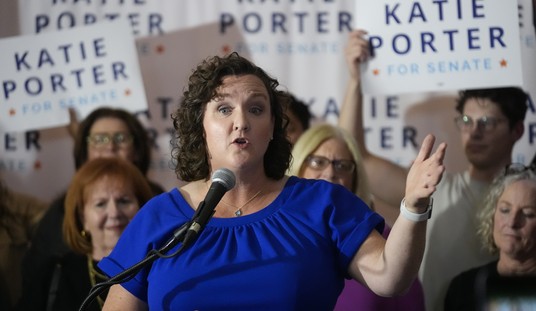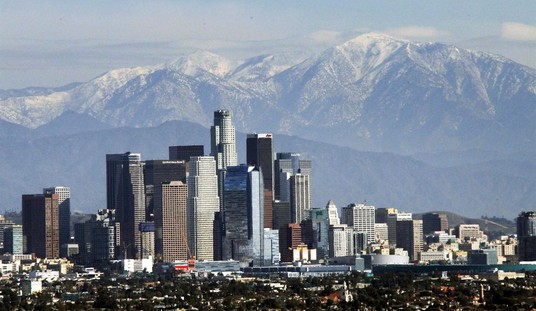
Supreme Court nominee Neil Gorsuch smiles during a lighter moment before answering questions on Capitol Hill in Washington, Tuesday, March 21, 2017, during his confirmation hearing before the Senate Judiciary Committee. (AP Photo/Pablo Martinez Monsivais)
In August, the Trump Administration announced a new immigration rule by way of the Federal Register. Under the new rule, the permanent residency of any legal alien was placed into jeopardy if they became a ‘public charge’ by receiving benefits in the form of cash assistance, food stamps, Medicaid, or housing subsidies for a total of 12 months in any three-year period.
This is good public policy. When immigrants passed through Ellis Island they either had to have sponsorship from friends or family already in America or have $30 in cash (about $785 today), the bottom line is that they had to show that they were capable of sustaining themselves and would not become a, wait for it, ‘public charge.’ This has been the law of the land since at least 1882.
However, to hear the shrieking, one would think that Chicken Little had looked up and seen the sky descending.
The rule went into effect on October 10. On October 11, the #Resistance in the federal judiciary went into action.
In short order, Federal district judges in five states–New York, California, Washington, Illinois, and Maryland–issued injunctions blocking the implementation of DHS’s revised public charge rule. The administration appealed. In December, the Ninth Circuit, in a unique act of sanity, lifted the injunctions from California and Washington, while the Fourth Circuit lifted the Maryland injunction. The government’s appeal in Illinois is still in progress. But just two weeks ago, in the Second Circuit, NeverTrump craziness overcame judicial modesty and the ruling by a single New York judge putting a halt to enforcement of the rule nationwide…even in two circuits where the injunction had been lifted…was upheld. The Trump administration lodged an emergency appeal with the Supreme Court.
Today, in a 5-4 decision (all those NeverTrumpers who thought ‘but Gorsuch’ was such a killer comeback against Trump can really just eat my unwashed shorts) the Supreme Court lifted all the injunctions in effect and ordered them kept that way until the case was settled.
This was a welcome development made all the sweeter by the snot-slinging and whimpering on the left.
SCOTUS (and super impartial, apolitical Chief Justice Roberts) have decided America will only be accepting wealthy immigrants and that Ellis Island and Emma Lazarus can go fuck themselves. https://t.co/kvvZbiq7Qj
— Adam Parkhomenko (@AdamParkhomenko) January 27, 2020
The Supreme Court gave @realDonaldTrump’s cruel public charge rule the green light today. This rule was intended to confuse and scare immigrant families, and it’s working. The people who will suffer the most are the poor and vulnerable among us – particularly children. https://t.co/elbJzuG85b
— Senator Mazie Hirono (@maziehirono) January 28, 2020
The Trump Administration's cruelty knows no bounds. The #PublicCharge rule is designed to scare immigrants and prevent them from accessing basic services. This is a racist attempt to discriminate against immigrants. https://t.co/w0KFYsZqdn
— Rep. Ted Lieu (@RepTedLieu) January 27, 2020
The lifting of that injunction was not really the news. It was plainly obvious that the injunctions were simply efforts by a few Trump-hating judges to stick a finger in the eye of the administration. We’ve seen this crude little drama acted out nearly constantly since early 2017 and the so-called ‘Travel Ban.’ The administration not only had black-letter law and precedent in their favor, they’d followed the rule-making procedure. This was simply a way of gumming up the works.
The news was that while 7 justices did not record their reason for striking down the illegal injunctions, two, Justices Clarence Thomas and Neil Gorsuch, did so. And their reasoning says that the old rules may be about to change.
…Approximately 10 months and 266,000 comments later, the agency issued a final rule. Litigation swiftly followed, with a number of States, organizations, and individual plaintiffs variously alleging that the new definition violates the Constitution, the Administrative Procedure Act, and the immigration laws themselves. These plaintiffs have urged courts to enjoin the rule’s enforcement not only as it applies to them, or even to some definable group having something to do with their claimed injury, but as it applies to anyone.
These efforts have met with mixed results. The Northern District of California ordered the government not to enforce the new rule within a hodge-podge of jurisdictions—California, Oregon, Maine, Pennsylvania, and the District of Columbia. The Eastern District of Washington entered a similar order, but went much farther geographically, enjoining the government from enforcing its rule globally. But both of those orders were soon stayed by the Ninth Circuit which, in a 59-page opinion, determined the government was likely to succeed on the merits. Meanwhile, across the country, the District of Maryland entered its own universal injunction, only to have that one stayed by the Fourth Circuit. And while all these developments were unfolding on the coasts, the Northern District of Illinois was busy fashioning its own injunction, this one limited to enforcement within the State of Illinois.
If all of this is confusing, don’t worry, because none of it matters much at this point. Despite the fluid state of things—some interim wins for the government over here, some preliminary relief for plaintiffs over there—we now have an injunction to rule them all: the one before us, in which a single judge in New York enjoined the government from applying the new definition to anyone, without regard to geography or participation in this or any other lawsuit. The Second Circuit declined to stay this particular universal injunction, and so now, after so many trips up and down and around the judicial map, the government brings its well-rehearsed arguments here.
Today the Court (rightly) grants a stay, allowing the government to pursue (for now) its policy everywhere save Illinois. But, in light of all that’s come before, it would be delusional to think that one stay today suffices to remedy the problem. The real problem here is the increasingly common practice of trial courts ordering relief that transcends the cases before them. Whether framed as injunctions of “nationwide,” “universal,” or “cosmic” scope, these orders share the same basic flaw—they direct how the defendant must act toward persons who are not parties to the case.
Equitable remedies, like remedies in general, are meant to redress the injuries sustained by a particular plaintiff in a particular lawsuit. When a district court orders the government not to enforce a rule against the plaintiffs in the case before it, the court redresses the injury that gives rise to its jurisdiction in the first place. But when a court goes further than that, ordering the government to take (or not take) some action with respect to those who are strangers to the suit, it is hard to see how the court could still be acting in the judicial role of resolving cases and controversies. Injunctions like these thus raise serious questions about the scope of courts’ equitable powers under Article III. See Trump v. Hawaii, 585 U. S. ___, ___ (2018) (THOMAS, J., concurring); Bray, Multiple Chancellors: Reforming the National Injunction, 131 Harv. L. Rev. 417, 471–472 (2017) (Bray); Morley, De Facto Class Actions? Plaintiff- and Defendant-Oriented Injunctions in Voting Rights, Election Law, and Other Constitutional Cases, 39 Harv. J. L. & Pub. Pol’y 487, 523–527 (2016).
It has become increasingly apparent that this Court must, at some point, confront these important objections to this increasingly widespread practice. As the brief and furious history of the regulation before us illustrates, the routine issuance of universal injunctions is patently unworkable, sowing chaos for litigants, the government, courts, and all those affected by these conflicting decisions. Rather than spending their time methodically developing arguments and evidence in cases limited to the parties at hand, both sides have been forced to rush from one preliminary injunction hearing to another, leaping from one emergency stay application to the next, each with potentially nationwide stakes, and all based on expedited briefing and little opportunity for the adversarial testing of evidence.
This is not normal. Universal injunctions have little basis in traditional equitable practice. Bray 425–427. Their use has proliferated only in very recent years. See Trump, 585 U. S., at ___–___ (THOMAS, J., concurring) (slip op., at 8–9). And they hardly seem an innovation we should rush to embrace. By their nature, universal injunctions tend to force judges into making rushed, high-stakes, low-information decisions. Bray 461–462. The traditional system of lower courts issuing interlocutory relief limited to the parties at hand may require litigants and courts to tolerate interim uncertainty about a rule’s final fate and proceed more slowly until this Court speaks in a case of its own. But that system encourages multiple judges and multiple circuits to weigh in only after careful deliberation, a process that permits the airing of competing views that aids this Court’s own decisionmaking process. Ibid. The rise of nationwide injunctions may just be a sign of our impatient times. But good judicial decisions are usually tempered by older virtues.
Nor do the costs of nationwide injunctions end there. There are currently more than 1,000 active and senior district court judges, sitting across 94 judicial districts, and subject to review in 12 regional courts of appeal. Because plaintiffs generally are not bound by adverse decisions in cases to which they were not a party, there is a nearly boundless opportunity to shop for a friendly forum to secure a win nationwide. Id., at 457–461. The risk of winning conflicting nationwide injunctions is real too. Id., at 462–464. And the stakes are asymmetric. If a single successful challenge is enough to stay the challenged rule across the country, the government’s hope of implementing any new policy could face the long odds of a straight sweep, parlaying a 94- to-0 win in the district courts into a 12-to-0 victory in the courts of appeal. A single loss and the policy goes on ice— possibly for good, or just as possibly for some indeterminate period of time until another court jumps in to grant a stay. And all that can repeat, ad infinitum, until either one side gives up or this Court grants certiorari. What in this gamesmanship and chaos can we be proud of?
I concur in the Court’s decision to issue a stay. But I hope, too, that we might at an appropriate juncture take up some of the underlying equitable and constitutional questions raised by the rise of nationwide injunctions.
Thomas and Gorsuch have complained long and loud about lower court judges arrogating to themselves the power to decide issues that are not even before their court. As Gorsuch points out, not only was there no one involved here that had suffered actual inconvenience much less injury. The delivery of this scathing dismissal of solitary federal judges deluding themselves that they have the power to write orders for the entire nation serves as a warning shot that their patience has run out and that future injunctions will be given short shrift. As it stands right now, the only place where the rule is in being debated is in Illinois. When that decision is reached and an injunction is ordered, it, too, will be put on hold by the Seventh Circuit.
This mindless Trump-hate that has infected the left and Never Trump, to the extent that you can even tell them apart anymore, is having some salutary side effects. The Supreme Court has become accustomed to lifting these illegal injunctions as soon as they are appealed. The well is being poisoned at Circuit Court level (when a NeverTrump ruling is shot down by the Ninth Circuit, you know you’ve jumped the shark). And a firm Supreme Court ruling that forbids judges from engaging in speculative injunctions that reach outside their courtrooms is on the horizon.













Join the conversation as a VIP Member